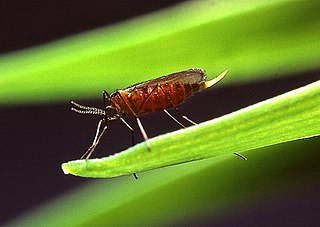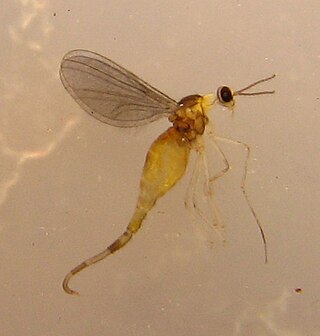Jean-Jacques Kieffer was a French naturalist and entomologist who specialised in the study of parasitic insects. Educated as a priest, Kieffer taught natural science in Bitche, Lorraine while working on the description and classification of insects. His work and publications later became a predominant source of description and classification for entomologists in the early 20th century, in particular with regard to parasitoid wasps, midges, and mosquitos.

The Cecidomyiinae, commonly known as gall midges or gall gnats, is the largest subfamily in Cecidomyiidae with over 600 genera and more than 5000 described species. This subfamily is best known for its members that induce galls on plants, but there are also many species that are fungivores, parasitoids, or predators as maggots.

The Lasiopteridi is a supertribe of flies from the family Cecidomyiidae. They are often called gall midges or gall gnats.

Mayetiola are a genus of flies from the family Cecidomyiidae. Most species are pests of cereal crops.

Contarinia is a genus of midges, small flies in the family Cecidomyiidae. There are over 300 described species in the genus.

Rabdophaga is genus of flies in the family of gall midges Cecidomyiidae. There are 105 species distributed through Africa, Asia, Europe and North America. Most species of Rabdophaga gall willows ; one exception is R. giraudiana which galls the stems of poplars.

Asphondylia is a cosmopolitan genus of gall midges in the family Cecidomyiidae. All species in this genus induce galls on plants, especially on flowers and flower buds. There are over 300 described species in Asphondylia, with many more likely to be discovered and described, especially in the southern hemisphere.

Asphondyliini is a tribe of gall midges in the family Cecidomyiidae. There are about six genera and at least 100 described species in Asphondyliini.
Micromyini is a tribe of wood midges, insects in the family Cecidomyiidae. There are about 9 genera and at least 30 described species in Micromyini.
Micromyinae is a subfamily of wood midges, insects in the family Cecidomyiidae. Its members were formerly included in subfamily Lestremiinae. There are at least 55 genera and more than 650 described species in Micromyinae. All species in this subfamily are mycophageous.

Janetiella is a genus of gall midges in the family Cecidomyiidae. There are at least thirty described species.

Winnertzia is a genus of gall midges and wood midges in the family Cecidomyiidae. There are more than 90 described species in Winnertzia.
Anabremia is a genus of gall midge in the family Cecidomyiidae. The six described species are found in the Palearctic and likely inquilines of Dasineura galls on plants in the legume family. This genus was first described by Jean-Jacques Kieffer in 1912.
Massalongia is a genus of flies in the family Cecidomyiidae. The larvae induce galls on birches.

Mikiola is a genus of flies belonging to the family Cecidomyiidae.
Lestremiinae is a subfamily of Cecidomyiidae. It is composed of 105 described species classified into 13 genera. The larvae feed on fungi, primarily in rotting wood.
Lestremia is a genus of midges in the family Cecidomyiidae. There are 18 described species in this genus. It was established by French entomologist Pierre-Justin-Marie Macquart in 1826.
Bryomyia is a genus of midges in the family Cecidomyiidae. The six described species are found in the Holarctic and Oriental regions. The genus was first described by Jean-Jacques Kieffer in 1895.
Peromyia is a genus of wood midges in the family Cecidomyiidae. There are 203 described species in Peromyia. The genus was established by Jean-Jacques Kieffer in 1894.
Strobliella is a genus of midges in the family Cecidomyiidae. The one described species - Strobliella intermedia - is found in the Holarctic region. The genus was established in 1898 by Jean-Jacques Kieffer.








